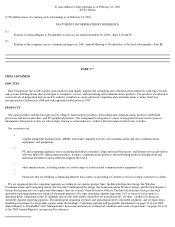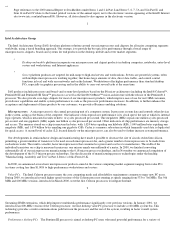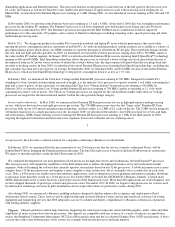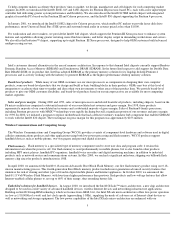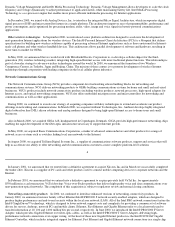Intel 2000 Annual Report Download - page 12
Download and view the complete annual report
Please find page 12 of the 2000 Intel annual report below. You can navigate through the pages in the report by either clicking on the pages listed below, or by using the keyword search tool below to find specific information within the annual report.
communications products will continue to compete successfully with products from existing competitors or products from new entrants to these
market segments.
In the cellular wireless communications business, our strategy is to deliver feature-rich, enhanced flash memory products and high-speed
processors for handheld wireless devices that require high performance and low power. In supplying these products, our Wireless
Communications and Computing Group faces competition from established companies in the flash memory, applications processor and
baseband chipset market segments.
13
RESEARCH AND DEVELOPMENT
Our competitive position has developed to a large extent because of our emphasis on research and development. This emphasis has enabled
us to deliver leading-edge technology and has permitted our customers to commit to the use of these new products in the development of their
own products. Our research and development activities are directed toward developing new products, hardware technologies and manufacturing
processes, as well as improving existing products and lowering costs.
A substantial majority of the design and development of components and other products is performed in the United States at our facilities in
California, Oregon, Arizona and Washington. Outside the United States, we have product development facilities at various locations, including
Israel, Denmark and Malaysia. We also maintain research and development facilities dedicated to improving manufacturing processes in
Arizona, California and Oregon.
In 2000, we shipped thousands of prototype processors based on the IA-64 architecture for high-end servers, under the Itanium brand, and
began to ship processors for systems used by information technology end users in pilot installations. We expect the release of production
systems during 2001. The Itanium processor is built on the 0.18-micron process technology. During 2000, approximately half of our
microprocessor research and development budget was spent on initiatives related to the server and workstation market segment.
In addition to microprocessor and chipset research and development, we have research and development initiatives in wireless devices,
networking and communications products, connected peripherals and other areas. These research and development initiatives include projects
surrounding the Intel XScale micro-architecture for wireless devices and the Intel IXA architecture for networking and communications
products. We have also acquired ongoing research and development activities in these areas with businesses acquired in 2000.
Our expenditures for research and development were $3,897 million in fiscal year 2000, $3,111 million in fiscal year 1999 and
$2,509 million in fiscal year 1998. These amounts exclude charges for purchased in-process research and development related to acquisitions
of $109 million for fiscal year 2000, $392 million for fiscal year 1999 and $165 million for fiscal year 1998. At December 2000, we had
approximately 20,500 employees engaged in research and development. The success of our research and development activities is dependent
upon competitive circumstances as well as our ability to bring new products to market in each computing market segment and in our other
businesses in a timely and cost-effective manner.
ACQUISITIONS AND STRATEGIC INVESTMENTS
During 2000, we acquired 16 businesses for more than $2.7 billion, augmenting our capabilities in a number of strategic areas. The
companies acquired included Ambient, GIGA, Picazo, Basis, Trillium and Ziatech. These acquisitions are discussed under the "Products"
heading in Part I, Item 1 of this Form 10-K in connection with each related business group.
Under our Intel Capital program, we also make equity investments to further our strategic objectives and to support our key business
initiatives in the areas of desktop and mobile platforms, server platforms, networking and communications, and Internet services. We want to
stimulate growth in computing, communications and the Internet, and to grow the total information infrastructure, in order to create and expand
markets for our products. This strategic investment program helps advance our overall mission of being a leading provider of key building
blocks to the Internet economy. While financial returns are not our primary goal, our strategic investment program seeks to invest in companies
that can succeed and have an impact on their market segment. When the strategic objectives of an investment have been achieved, or if the
investment diverges from our strategic objectives, we may decide to dispose of the investment. As of year-end 2000, our strategic equity
portfolio was valued
14
at approximately $3.7 billion, including marketable investments at their market value and non-marketable investments at cost.
INTELLECTUAL PROPERTY AND LICENSING



